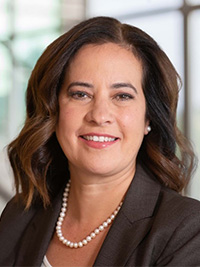Doctors at NewYork-Presbyterian/

Larissa Rodríguez, MD
For Larissa Rodríguez, MD, Chair of the Department of Urology and Urologist-in-Chief at NewYork-Presbyterian/
“The center has physicians from colorectal, urology, gynecology, and rehabilitation medicine, as well as physical therapists, in one place where patients will be able to go and be evaluated by a combination of practitioners,” says Dr. Rodríguez, a urologic surgeon who specializes in female pelvic medicine and reconstructive surgery and urogynecology. She states that, “instead of having patients see two doctors and coordinating schedules, they will be able will be evaluated at the center by the different physicians, which will be really beneficial for patient care.”
Pelvic health conditions affect the ligament and muscular support in the pelvic region, which affect the function of pelvic organ such as the bowel, bladder, vagina, and uterus. Appropriately treating these conditions requires close collaboration amongst these experts.
The center is currently located 525 East 68th Street, Suite F9 West, New York, NY 10065 while the physical space is renovated. To contact the center, please call 646-962-9600.
Barriers to Care for Pelvic Floor Conditions
A lack of education or awareness about pelvic health can be a barrier to accessing appropriate care. “It’s amazing how little women may know about their own bodies, and even less about their pelvic floor,” Dr. Rodríguez says. “It’s not a common topic that mothers and daughters talk about. A lot of people don’t have control over it because they’ve never learned to control it. But it can be taught. In fact, you need to relax your pelvic floor to be able to have sex, orgasms, urinate, and defecate. And you need to contract it to not leak urine.”
“It’s amazing how little women may know about their own bodies, and even less about their pelvic floor. It’s not a common topic that mothers and daughters talk about. A lot of people don’t have control over it because they’ve never learned to control it. But it can be taught.” — Dr. Larissa Rodríguez
There are also health disparities that pose barriers for women seeking care for pelvic health conditions. “We know that Latina women present with much more advanced prolapse than other racial groups and when they have surgery, they have worse outcomes,” she says. “We also know that African American women have more severe overactive bladder and urgency incontinence than other racial groups. We don’t understand why those disparities exist, but we do know that socioeconomics, environment, and what’s happening in one’s life can be a factor in how these symptoms manifest.”
These health disparities and barriers to care are areas that Dr. Rodríguez plans to continue studying at the Center for Female Pelvic Health.
Ongoing Research in Pelvic Health
A distinguished physician-scientist, Dr. Rodríguez has a broad-based research portfolio extending from the laboratory into the clinic, which continues to be instrumental in advancing the field of pelvic medicine and voiding dysfunction. As a principal investigator of the NIH-sponsored Multidisciplinary Approach to the Study of Urologic Pelvic Pain (MAPP) Research Network, she and her colleagues have been conducting research on chronic pelvic pain disorders, including interstitial cystitis/painful bladder syndrome (IC/PBS) for over a decade.
Recently, Dr. Rodríguez and her MAPP colleagues conducted a study of interstitial cystitis/bladder pain syndrome and prostatitis/chronic pelvic pain syndrome, known collectively as urologic chronic pelvic pain syndrome (UCPPS). Because the symptoms of UCPPS are heterogenous, it makes defining appropriate clinical trial endpoints difficult. Dr. Rodríguez and the other researchers sought to identify clinically important differences (CIDs) for two primary measures of disease symptoms – Pelvic Pain Severity (PPS) and Urinary Symptom Severity (USS). The researchers found that a reduction of 30-50 percent in PPS is a clinically meaningful endpoint for future therapeutic trials in UCPPS. However, CIDs for USS should be differentiated by gender.
In another study of UCPPS, Dr. Rodríguez and her fellow MAPP researchers sought to determine if pelvic floor tenderness (PFT), which affects 85 percent of those with UCPPS, is a phenotypic predictor in UCPPS. The findings showed that UCPPS patients with higher PFT scores had worse pelvic pain, urinary symptoms, and quality of life, as well as a more centralized pain phenotype.
The role of environmental stress in the development and maintenance of urinary symptoms, voiding dysfunction, and bladder pain is another area of interest for Dr. Rodríguez. “We are studying stress and bladder-brain interactions,” she says. “It’s an area of multidisciplinary research we need to expand to determine which areas of the brain may control the pelvic floor, bladder, and rectum and how these areas interact with each other. Hopefully, in the future we could manipulate these brain areas to improve pelvic floor function.”
How pregnancy and vaginal deliveries affects a woman’s pelvic floor and how that leads to pelvic floor disorders, such as prolapse and incontinence, is something members of the center are hoping to better understand to develop interventions to prevent these disorders when women get older.
“This is fertile ground for us to come together to better understand pelvic floor disorders, develop new therapies, and figure out how to prevent these conditions.”
Dr. Rodríguez believes that the new center will provide tremendous research opportunities to advance the care of women with pelvic floor disorders. “This is fertile ground for us to come together to better understand pelvic floor disorders, develop new therapies, and figure out how to prevent these conditions,” she says.



